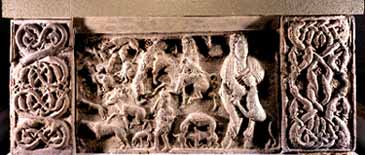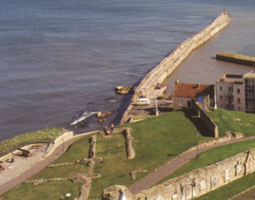
Photo: RCHAMS
 Photo: RCHAMS |
Christian worship at this spot began perhaps around 800 AD when the Celtic "Culdees" (Companions of God) established a makeshift church at the harbour entrance. This was shortly thereafter replaced with the church of St. Mary-on-the-Crag whose outline, outside the cathedral walls is still evident. It is probable that the relics of St. Andrew were kept at that site.
 The cruciform foundation of St. Mary on the Crag church is visible in the foreground |
After roughly three centuries the Roman form of worship supplanted the Celtic. The original Holy Trinity "town" church was built on the site of the later cathedral. The existing Holy Trinity Church in South Street being a much later construction.
The Construction of the cathedral began in 1159, but it wasn't until 1318 that the cathedral was consecrated in the presence of King Robert the Bruce. It is even alleged that he rode his horse up the aisle.
The relics of St. Andrew have disappeared. There are two theories of what may have happened to them ... One is that the Culdees, not wanting to have the relics become part of the Roman church, removed them to their monastry of St. Serf on Loch Leven. The other theory is that they were discarded by the iconoclasts of the Reformation.
The reformers of the 16th century have most certainly been wrongly accused of the destruction of the cathedral. It is very likely that they did indeed tear down statuary and other religious icons, but the cathedral was ruined more by poor design which was unable to withstand the harsh North Sea winds. The gable of the South Transept was blown down by a fierce storm in 1409. An earlier fire in 1378 meant that building on the cathedral had to be almost completely restarted. Ultimately cathedral stone was used as a source of stone for local buildings.
Today the cathedral grounds are an interesting and peaceful environment in which to contemplate the events of the last millenium. Grave stones of many prominent local people, statesmen, clerics and golfers are to be found there. There is also a haunted tower in which it is alleged the "White Lady of St. Andrews" was buried.